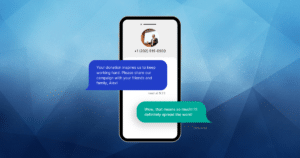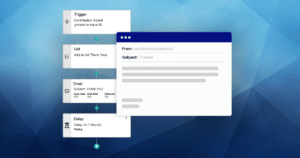In the world of fundraising, text messaging has become somewhat of an essential tool for reaching donors. Short and concise, SMS messages offer a direct and efficient way to convey important information. However, as campaigns, committees, PACs, and other nonprofits increasingly rely on text messaging for their communication needs, it is crucial to ensure that these messages are delivered reliably and without interruption. This is where registering for a 10DLC (10-Digit Long Code) becomes important.
What follows is a crash course for understanding what 10DLC is, what entities regulate 10DLC traffic, and how you can register and stay compliant with 10DLC to help your organization’s outreach. Let’s dig in!
10DLC Terms and Definitions
What is 10DLC?
Imagine reaching your donors directly on their phones, just like a friend, but with the power of mass communication. That’s what 10DLC offers! It stands for 10-Digit Long Code, which means it’s just a regular phone number like the one on your business card (think 555-FUND-HOPE). Forget short codes or toll-free numbers – 10DLC builds trust and familiarity, making your message stand out.
Why is 10DLC important?
If you’re thinking of using your organization’s phone number(s) to send text messages to supporters, 10DLC becomes crucial.
Here’s why:
- It’s the new regulation for business text messaging in North America. Carriers require organizations to register their numbers under the 10DLC framework for sending bulk SMS and MMS messages.
- It ensures a better experience for everyone. 10DLC helps prevent spam and unwanted texts, protecting customers while improving message deliverability for businesses.
- It opens up new possibilities. By complying with 10DLC, you can leverage the power of text message marketing, reaching your audience directly and engaging them in a way that email often struggles to match.
So, does 10DLC apply to you?
If your organization has or intends to obtain a phone number and to use it for text messaging, then yes, 10DLC applies to you.
But don’t worry! Navigating these regulations doesn’t have to be complicated. Many resources and tools are available to help you understand the requirements and register your number(s) seamlessly.
Remember:
- Using 10DLC is essential for responsible and compliant business text messaging.
- With the right guidance, complying with 10DLC can be a smooth and rewarding experience.
What is 10DLC Registration?
10DLC is kind of like the DMV for business texting, but way simpler. US carriers are saying, “Enough is enough!” with random bulk texts flooding their networks. So, they created 10DLC to ensure businesses and organizations sending bulk messages are legit. Registering is now mandatory to keep your messages flowing smoothly. 10DLC registration is your ticket to reliable, cost-effective texting with your business number.
What is A2P messaging?
Think Texting, But Smarter:
Forget about traditional texting from your phone. A2P messaging is like having a supercharged texting assistant working for your business. It stands for Application-to-Person, meaning it uses software like Campaign Deputy to send messages directly from your computer, not your phone.
What’s the difference?
Before, A2P was mostly about automated messages, like appointment reminders. Now, it’s evolved to handle two-way conversations that look and feel just like regular texting. This lets businesses connect with customers in a more personal and engaging way.
What is the Campaign Registry?
The Campaign Registry (TCR) is essentially the central hub for registering and managing 10-digit long code (10DLC) messaging campaigns in the United States. It’s like a traffic controller for business text messages, ensuring they are sent responsibly and ethically. Here’s a breakdown of what the Campaign Registry does:
- Registers businesses and their messaging campaigns: This helps improve transparency and accountability, making it easier for carriers and customers to identify who is sending what messages. This also ensures your messages are being sent reliably, and at scale.
- Sets standards for A2P messaging: This involves things like requiring opt-in consent, defining acceptable message content, and preventing spam.
- Facilitates communication between businesses and carriers: This ensures everyone is on the same page and helps resolve any issues related to messaging traffic.
What is Campaign Deputy’s role in 10DLC and The Campaign Registry?
Our goal is to help your organization navigate 10DLC messaging and compliance effectively! That means avoiding unnecessary surcharge fees and delays in A2P message deliverability. We are already a participating communications service provider (CSP) partner with The Campaign Registry and offer you the ability to register brands within our platform.
The aim is to provide your organization with authorized 10DLCs so you can solicit donations and broadcast necessary information directly to consenting supporters in the fastest way we know how. In addition, our support team and messaging experts are here to help you with ensuring compliance, and any additional questions you may have about this process.
What are the 10DLC Regulations?
There are many 10DLC regulations and process changes that affect the telecommunications industry, but only a few that matter for political organizations like yours.
- Your organization must register with The Campaign Registry – in this case, through Campaign Deputy.
- Your organization must also be vetted through the Campaign Verify service.
- You must prove that your contacts have opted-in to receive texts from you.
- Businesses in some industries will be rejected outright, like those in cannabis/hemp, firearms, third-party collections, payday loans, and those selling other illicit materials.
Campaign Deputy will handle most of this for you. If you have questions, just ask.
Mobile carriers implemented 10DLC regulations to prevent bad actors from posing as legitimate businesses and spamming or scamming contacts who never asked to be texted.
The goal of 10DLC regulation is to ensure consumers get messages they want, that they are not harmed by bad actors, and to keep texting a clean and effective channel for business communications.
How Do I Register My Organization's 10DLC?
1. Gather your organization’s info.
To get your account ready for 10DLC, you’ll need to provide us with the following information:
- Your organization’s legal name
- Your organization’s address (as registered with the IRS)
- Organization type (private, publicly traded, nonprofit)
- Your organization’s tax number/ID/EIN
- Your organization’s website (or a social media page)
- Descriptions of each use case you text for
- Sample messages for each use case
- A description of how you have acquired or will acquire phone numbers
that are opted in to receive messages from your organization. - A message to display if a number opts in to receive messages from your
organization. - A message to display if a user sends the HELP keyword to your messages.
- Any additional keywords you would like to add that would allow users to
opt in to receive message from your organization.
2. Get verified with the Campaign Verify service.
Our texting vendor requires that your organization be verified by this service. Once Campaign Verify has vetted your organization, you will receive a unique token that must be submitted to us to allow your organization to send texts.
Campaign Verify may take up to two business days to vet your organization, so your token does not need to be submitted immediately upon applying for 10DLC. However, no text messages can be sent until a token has been provided.
3. Get approved or rejected by Campaign Verify.
The good news is we’ll hear back soon. The less good news is there’s another step before you can start texting.
4. Submit information.
Once you’ve collected all the pieces above, you’re ready to apply! Keep in mind, this process is unique to Campaign Deputy users, and may not look the same for everyone.
How to Prove Opt-Ins
1. Add opt-in language to your contact forms, with a required checkbox.
2. Add opt-in language and opt out language to your terms of service.
See below for sample opt-in language. Common examples of opt-out language include: Reply STOP to opt out. To stop receiving messages from [Campaign Name], reply STOP, CANCEL, or UNSUBSCRIBE.
3. Use keywords to prompt inbound messages.
Using a keyword prompt, like “Text DEALS for text alerts about new items and discounts” is a great opt-in option, because contacts are intentionally texting you to get something in return. If this applies to your organization, be sure to add your keyword prompt to your website.
4. Add “Text or call us” wherever you have your phone number.
Sample Opt-In Language
Here are examples of opt-in language we recommend. We cannot guarantee results, but we do recommend using the samples below or some variation of them.
Note: We are not lawyers, and this does not constitute legal advice.
- You have successfully been subscribed to this number. Reply STOP to unsubscribe. Msg&Data Rates May Apply.
- By texting us, you agree to receive text messages at the number provided. Standard message and data rates apply.
- By checking this box you agree to receive text messages at the number provided.
- I wish to receive text messages at the number provided. Standard message/data rates apply.
How to Prevent Being Marked as SPAM
While getting your 10DLC registration is key to sending texts legally, remember, it’s not a free pass to spam everyone! Carriers still watch how you send messages, and some practices can still get flagged as spam. Here’s what to avoid:
- Shortened URLs: Public shortening services like Bit.ly raise red flags. Use full, clear website links instead.
- Link-heavy endings: Don’t end messages with just a link, especially without context. Explain what the link offers first.
- Missing HTTPS: Always include “https://” at the start of all links for security.
- Excessive formatting: Caps, multiple dollar signs, or too many emojis scream spam. Text naturally.
- Mass identical messages: Avoid sending the same exact message to huge groups. Personalize messages whenever possible.
- Longtexts to everyone: Sending extra-long messages to thousands could trigger spam filters. Keep messages concise and relevant.
In short, follow common texting etiquette, and you’ll stay on the right side of the line. Text like a friend, not a robot, and your messages will land as intended.
Conclusion
In today’s fast-paced fundraising world, effective communication is essential for success. Registering a 10DLC for your organization offers numerous benefits, including enhanced deliverability, compliance with regulations, and scalability. By taking the necessary steps to register your 10DLC, you establish trust, improve message delivery, and position your organization for growth.
FAQs
Q: How long does the 10DLC registration process take?
A: The registration process can vary depending on the service provider and the complexity of your campaign. It can take anywhere from a few days to a few weeks. It’s important to plan ahead and allow sufficient time for the registration and approval process.
Q: Can I register for 10DLC if I’m a grassroots campaign?
A: Absolutely! 10DLC is designed to be accessible to organizations of all sizes. Whether you’re running for City Council or a Senate seeker, you can register for 10DLC and leverage its benefits to enhance your communication with supporters.
Q: Can I use my existing business phone number for 10DLC?
A: In most cases, you will need to obtain a dedicated 10DLC phone number for your SMS campaigns. This ensures that your messages are delivered reliably and helps maintain the integrity of your brand. Your 10DLC service provider can assist you in acquiring a dedicated number.
Q: Are there any restrictions on the content of 10DLC messages?
A: Yes, there are certain restrictions on the content of 10DLC messages to ensure compliance with industry regulations. Avoid sending unsolicited marketing messages and ensure that your messages are relevant, non-spammy, and adhere to applicable laws and guidelines.
Q: Can I switch 10DLC service providers after registration?
A: While it is possible to switch 10DLC service providers, it can be a complex process. It is advisable to carefully choose your service provider from the beginning to avoid any complications. Consider factors such as pricing, features, and customer support before making your decision.




